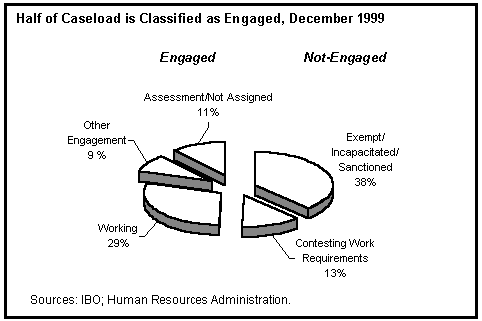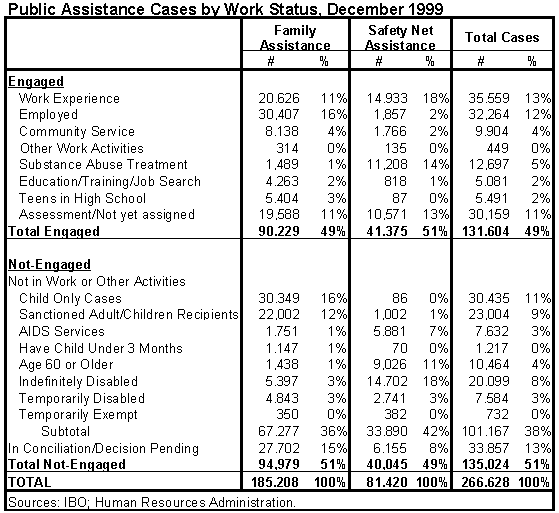On July 20, 1998, Mayor Giuliani announced that he would end welfare dependency by the year 2000 and replace it with work in exchange for earnings. Right before the beginning of the new year, the Mayor announced that this goal had been accomplished; the city had achieved "full engagement" in work activities for all able-bodied public assistance recipients.
This newsfax provides-for the first time-information on public assistance recipients' activities when full engagement was achieved. It also shows that the definition of full engagement that the Mayor is currently using is looser than the extremely strict work requirements he outlined when announcing the new policy.
The 1998 announcement stated that all family heads and single adults receiving Family Assistance (FA) or Safety Net Assistance (SNA) would be required to participate in a full-time 35 hour work week; only the severely disabled and mothers with newborns would be exempt. Individuals with physical or other limitations not severe enough to qualify for disability payments would be provided with work opportunities in specialized work settings.

IBO estimated that these strict standards could have required about 80 percent of the caseload (219,000 cases) to participate in work activities (see Welfare Reform Revisited: Implementation in New York City, September 1998). This would have been an additional 150,000 adult recipients on top of the 69,000 already participating.
In fact, when the Mayor announced that the city had achieved its goal, roughly half of the caseload was engaged in work activities or being assessed. Human Resources Administration (HRA) data for December 1999 classifies 132,000, or 49 percent, of the 267,000 cases receiving assistance as engaged.
About 29 percent of the total caseload (over half of the engaged cases) had at least one adult who was working. This included 36,000 participants in the city's Work Experience Program (WEP), 32,000 working in private employment, and 10,000 in community service or other work activities. Another 9 percent of the caseload classified as engaged included individuals who were in substance abuse treatment; in education, training or job search programs; or teen parents who were in high school.
The remaining 30,000 engaged cases-roughly 11 percent of the caseload-were being assessed and had not yet been assigned to a work activity.
The actual increase in work activities is much less than IBO had estimated under the original guidelines. Virtually all of the increase in individuals working has occurred among those in private employment whose earnings are low enough to allow them to remain eligible for public assistance. This is consistent with the city's emphasis on private sector job placements. There was little growth in WEP, in which participants work for public or non-profit agencies in return for receiving their monthly public assistance grant.
In contrast to IBO's estimate that the original strict requirements would exempt only 20 percent of the caseload, in December 1999 slightly more than half of the total caseload was not engaged. Roughly 38 percent did not participate in work or related activities. This includes over 30,000 child-only cases, in which the adults were not eligible for public assistance because, for example, they received supplemental security income. Another 23,000 were cases in which children received benefits but the adults' public assistance benefits were withdrawn generally because of failure to participate in work activities. Another 19,000 were exempt due to AIDS, caring for a newborn, or because they were elderly. And 27,500 were classified as indefinitely or temporarily disabled. The balance of those not engaged-13 percent of the caseload or almost 34,000 cases-were contesting their work requirements.
It is not clear if the city has attained an optimum level of work activity. There may be other public assistance recipients who would benefit from placement into work or training programs appropriate to their needs. Conversely, there may be some individuals in work and training programs that would be better served by other activities.
The adoption of a more flexible definition of full engagement, however, has distinct advantages for the city. While easily fulfilling the federal and state work requirements, the current policy avoids the need for a major infusion of city funds. Had the city implemented a massive work program based on the original guidelines, IBO estimated that it would have cost more than $500 million annually. The current policy also avoids the logistical problems involved in trying to find appropriate work slots for those individuals who are particularly needy and hard to place.
For more information call Paul Lopatto, Team Leader for Health and Social Services, at (212) 442-8613.
